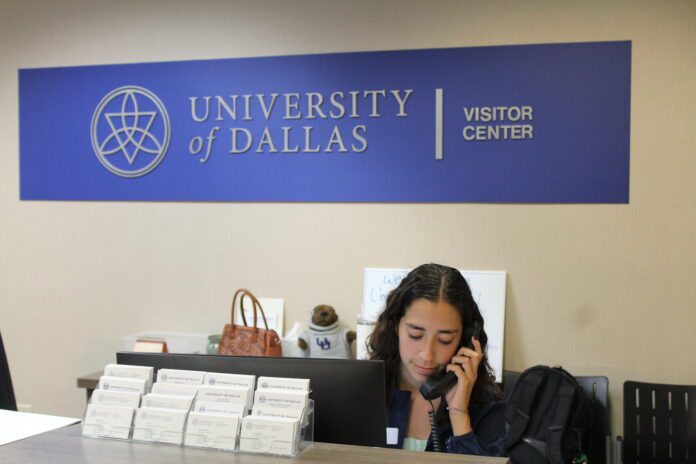
Admissions provides context for fluctuating class sizes
Class size is always important to universities, since it largely determines the revenue brought in that year. Not only does the University of Dallas have to meet enrollment quotas, but retaining the amount of students each year is just as, if not more, important than the initial enrollment.
Many factors contribute to class sizes varying from year to year. For instance, two years ago, incoming seminarians, of which there are usually 10 to 15, counted as freshmen. However, incoming seminarians have not been factored into the freshman class size either this past year or currently. Next year the policy will change once again, and seminarians will be included in the official class size.
Typically, class sizes stay in the mid 300’s to low 400’s. In the application season for the 2020-2021 academic year, that freshman class stood just above 500 students, and then melted down to 473 when the school year started. The next class was 438 students, but shrunk to 404. The class of 2025 was UD’s second largest class ever, and when it shrank to 473, it became the third largest. Although an impressive statistic, the admissions team did not look too much into it.
Carey Christenberry, director of admissions, said, “Nobody really questioned why we had the largest class [that year]. Nobody ever said ‘Hey, this is the largest class. How and why did we do it?’ It was just like, ‘Wow, look what we got.’ And so there really wasn’t a deep investigation into what happened.”
There are known reasons, however, for the larger sizes of this year’s juniors and seniors.
“Some of this is speculative, and some of this is kind of anecdotal, but what we know is that COVID helped us,” said Christenberry.
COVID-19 changed the education scene dramatically. Since then, many universities have chosen to not require SAT or ACT scores in applications. For a short amount of time, UD was test-optional in order to adapt to the changing environment post-COVID-19, but for this year’s applicants, these test scores are now required again. Because of this, GPA and the other factors were weighed more heavily when considering accepting an application.
In 2020 and 2021, there was an increase in incoming freshmen. UD’s policies made in response to COVID-19 and the policies on vaccinations seemed to have contributed to this.
“My own personal thought is that the political environment that surrounded the last election was also very prevalent. I think that impacted [the class size] that we had. The political environment had kids thinking about locations where they would feel comfortable,” said Christenberry. “So you had more students that were looking at a place where COVID vaccines weren’t required, a place that was on campus where they were in-person and particularly a place where they felt that their views, whatever they would be, would be welcomed.”
The performance of the two freshmen classes during COVID was not as good as previous classes.
Dr. Brett Bourbon, professor of English, is teaching two Literary Tradition I classes this semester. He said, “The effect of COVID was pretty dramatic. Those classes that came after that were much, much more poorly prepared. The reading level was lower and the writing level was much lower.”
By contrast, the class of 2027 has impressed many.
Bourbon said, “I’ve generalized that sometimes it’s certain years where it’s like pulling teeth, just the lack of seriousness and maturity sometimes, but I don’t actually feel that that’s the case with both my classes.”
Last application season, UD chose to be more selective with its applicants. As such, this year’s freshmen make up a smaller class size with 348 students at the time of the census. With hopes of increasing the retention rates, the admissions team took more care to accept students with a higher chance of succeeding than they had in previous years.
“We were more selective last year, and the students that we accepted we were intentionally more selective of, because we have anecdotal evidence that our retention rate for the two [large freshman class] years was not as good as we would have liked it to be. And so in order to try to help with that we had to make sure that every student who was admitted to UD could handle its rigor,” said Christenberry. “It’s not the quantity but the quality of the freshman class that we have [this year] is awesome.”
Additionally, not a single homeschool application was rejected for last year’s group of applicants. The homeschool population of the class of 2027 possibly contributed to the overall quality of this year’s freshmen.
Natalie Williams, admissions counselor for the Fort Worth, Colleyville, and Southlake territories and homeschoolers, said, “The homeschoolers that are attracted to the University of Dallas are extremely well prepared, even homeschoolers who use their own curriculum.”
Although the freshman class might be smaller than previous years, they have managed to impress faculty, staff and fellow students, not with their quantity, but with their quality.
I wonder if it’s better to avoid extrapolating from anecdotes and generalizations, especially when questioning the quality of UD students? Data could always be helpful.